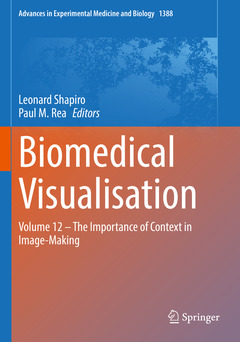Biomedical Visualisation, 1st ed. 2022 Volume 12 ‒ The Importance of Context in Image-Making Advances in Experimental Medicine and Biology Series, Vol. 1388
Coordonnateurs : Shapiro Leonard, Rea Paul M.

This image-rich book explores the practice as well as the theory of visual representation and presents us with the importance of designing appropriate images for communication to specific target audiences. This includes the appropriate choice of high-tech digital or low-tech analogue technologies in image-making for communication within the medical education, biological research and community health contexts.
We hear from medical students about the value of using clay modelling in their understanding of anatomy, from educators and curriculum designers about visual affordances in medical education and from a community-driven project in South Africa about their innovative use of locally designed images and culture-specific narratives for communicating important health information to marginalised communities. A chapter explores the evolution of scientific visualisation and representation of big data to a variety of audiences, and another presents the innovative 3D constructionof internal cellular structures from microscopic 2D slices. As we embrace blended learning in anatomy education, a timely chapter prompts us to think further about and contribute to the ongoing discourse around important ethical considerations in the use and sharing of digital images of body donors.
This book will appeal to educators, medical illustrators, curriculum designers, post-graduate students, community health practitioners and biomedical researchers.
Leonard Shapiro has a keen interest in Anatomy Education and has developed a number of art-derived exercises to address and improve students’ three-dimensional (3D) spatial awareness and observation ability. His courses and online workshops are in collaboration with lecturers who are actively engaged in improving education methodology in anatomy. These are offered to medical students and lecturers in South Africa and abroad. Leonard has developed a multi-sensory observation method that crucially employs the sense of touch (haptics) coupled with the simultaneous act of drawing. It is called the Haptico-visual observation and drawing (HVOD) method.
In anatomy education, the benefits of observing using the HVOD method includes the enhanced observation of the 3D form of anatomical parts, the cognitive memorization of anatomical parts as a 3D 'mental picture', improved spatial orientation within the volume of anatomical parts and an ability to draw. Leonard contributes tothe anatomy education discourse by presenting at anatomy conferences as well as via publications and articles. Leonard graduated in BSocSc and in BA Fine Art (Hons) from the University of Cape Town, South Africa.
Paul M. Rea - Paul is Professor of Digital and Anatomical Education at the University of Glasgow. He is Director of Innovation, Engagement and Enterprise within the School of Medicine, Dentistry and Nursing. He is also a Senate Assessor for Student Conduct, Council Member on Senate and coordinates the day-to-day running of the Body Donor Program and is a Licensed Teacher of Anatomy, licensed by the Scottish Parliament.
He is qualified with a medical degree (MBChB), a MSc (by research) in craniofacial anatomy/surgery, a PhD in neuroscience, the Diploma in Forensic Medical Science (DipFMS), and an MEd with Merit (Learning and Teaching in Higher Education). He is a Senior Fellow of the Higher Education Academy, professional member of the Institut
Date de parution : 09-2023
Ouvrage de 191 p.
17.8x25.4 cm
Date de parution : 09-2022
Ouvrage de 191 p.
17.8x25.4 cm


